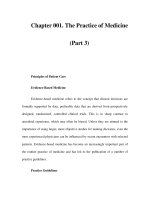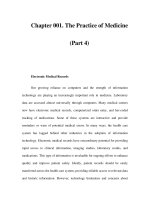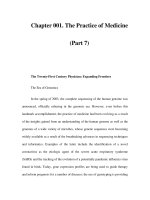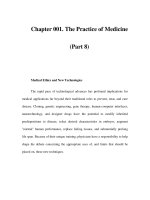Chapter 001. The Practice of Medicine (Part 2) ppt
Bạn đang xem bản rút gọn của tài liệu. Xem và tải ngay bản đầy đủ của tài liệu tại đây (12.5 KB, 5 trang )
Chapter 001. The Practice of Medicine
(Part 2)
Physical Examination
The purpose of the physical examination is to identify the physical signs of
disease. The significance of these objective indications of disease is enhanced
when they confirm a functional or structural change already suggested by the
patient's history. At times, however, the physical signs may be the only evidence
of disease.
The physical examination should be performed methodically and
thoroughly, with consideration for the patient's comfort and modesty. Although
attention is often directed by the history to the diseased organ or part of the body,
the examination of a new patient must extend from head to toe in an objective
search for abnormalities. Unless the physical examination is systematic and
performed in a consistent manner from patient to patient, important segments may
be inadvertently omitted. The results of the examination, like the details of the
history, should be recorded at the time they are elicited, not hours later when they
are subject to the distortions of memory. Skill in physical diagnosis is acquired
with experience, but it is not merely technique that determines success in eliciting
signs of disease. The detection of a few scattered petechiae, a faint diastolic
murmur, or a small mass in the abdomen is not a question of keener eyes and ears
or more sensitive fingers, but of a mind alert to these findings. Because physical
findings can change with time, the physical examination should be repeated as
frequently as the clinical situation warrants. Because a large number of highly
sensitive diagnostic tests are available, particularly imaging techniques, it may be
tempting to put less emphasis on the physical examination. Indeed, many patients
are seen for the first time after a series of diagnostic tests have already been
performed and the results known. This should not deter the physician from
performing a thorough physical examination since clinical findings are often
present that have "escaped" the barrage of preexamination diagnostic tests.
Diagnostic Studies
We have become increasingly reliant on a wide array of laboratory tests to
solve clinical problems. However, accumulated laboratory data do not relieve the
physician from the responsibility of carefully observing, examining, and studying
the patient. It is also essential to appreciate the limitations of diagnostic tests. By
virtue of their impersonal quality, complexity, and apparent precision, they often
gain an aura of authority regardless of the fallibility of the tests themselves, the
instruments used in the tests, and the individuals performing or interpreting them.
Physicians must weigh the expense involved in the laboratory procedures relative
to the value of the information they are likely to provide.
Single laboratory tests are rarely ordered. Rather, physicians generally
request "batteries" of multiple tests, which often prove useful. For example,
abnormalities of hepatic function may provide the clue to such nonspecific
symptoms as generalized weakness and increased fatigability, suggesting the
diagnosis of chronic liver disease. Sometimes a single abnormality, such as an
elevated serum calcium level, points to a particular disease, such as
hyperparathyroidism or underlying malignancy.
The thoughtful use of screening tests, such as low-density lipoprotein
cholesterol, may be quite useful. A group of laboratory determinations can be
carried out conveniently on a single specimen at relatively low cost. Screening
tests are most informative when directed toward common diseases or disorders
and when their results indicate the need for other useful tests or interventions that
may be costly to perform. On the one hand, biochemical measurements, together
with simple laboratory examinations such as blood count, urinalysis, and
sedimentation rate, often provide a major clue to the presence of a pathologic
process. On the other hand, the physician must learn to evaluate occasional
abnormalities among the screening tests that may not necessarily connote
significant disease. An in-depth workup following a report of an isolated
laboratory abnormality in a person who is otherwise well is almost invariably
wasteful and unproductive. Among the more than 40 tests that are routinely
performed as screening, it would not be unusual for one or two of them to be
slightly abnormal. If there is no suspicion of an underlying illness, these tests are
ordinarily repeated to ensure that the abnormality does not represent a laboratory
error. If an abnormality is confirmed, it is important to consider its potential
significance in the context of the patient's condition and other test results.
The development of technically improved imaging studies with greater
sensitivity and specificity is one of the most rapidly advancing areas of medicine.
These tests provide remarkably detailed anatomic information that can be a pivotal
factor in medical decision-making. Ultrasonography, a variety of isotopic scans,
CT, MRI, and positron emission tomography have benefited patients by
supplanting older, more invasive approaches and opening new diagnostic vistas.
Cognizant of their capabilities and the rapidity with which they can lead to a
diagnosis, it is tempting to order a battery of imaging studies. All physicians have
had experiences in which imaging studies turned up findings leading to an
unexpected diagnosis. Nonetheless, patients must endure each of these tests, and
the added cost of unnecessary testing is substantial. A skilled physician must learn
to use these powerful diagnostic tools judiciously, always considering whether the
results will alter management and benefit the patient.









